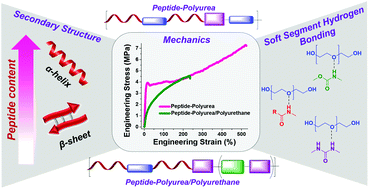Synthetic approach to tailored physical associations in peptide-polyurea/polyurethane hybrids†
Abstract
Nature has achieved diverse functionality via hierarchical organization driven by physical interactions such as hydrogen bonding. Synthetically, polymer–peptide hybrids have been utilized to achieve these architectural arrangements and obtain diverse mechanical properties, stimuli responsiveness, and bioactivity. Here, we explore the impact of peptide ordering and soft/hard phase interactions in PEG-based non-chain extended and chain extended peptidic polyurea (PU) and polyurea/polyurethane (PUU) hybrids towards tunable mechanics. Increasing the peptide content of poly(ε-carbobenzyloxy-L-lysine) (PZLY) revealed an increase in α-helical formation and modulation in amine/ether hydrogen bonding, suggesting enhanced intermolecular hydrogen bonding between peptide segments and soft/hard blocks. A balance of phase mixing and microphase segregation was observed depending on competitive hydrogen bonding and the hybrid architecture. This phase behaviour strongly modulated the mechanical response, particularly modulus and extensibility. We anticipate that this solid-state, synthetic framework will expand the reach of our peptide hybrids into biointerfacing materials, including scaffolds and responsive actuators via peptide selection.

- This article is part of the themed collection: Peptide Materials


 Please wait while we load your content...
Please wait while we load your content...